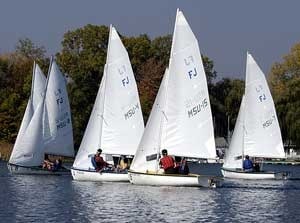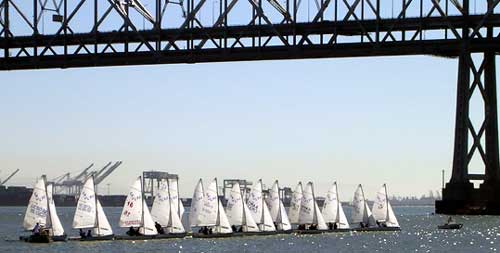
This past weekend the focus of the Midwest Collegiate Sailing Association was on Michigan State’s annual Cedarfest regatta, which was well attended by competitive teams from the district. There was fierce competition in both A and B divisions. As teams arrived at Lake Lansing on Saturday morning, they were greeted by a light fog and no wind. However, by the skippers meeting, the fog lifted and a light breeze built from the Southeast. Historically, the Cedarfest has been accompanied by cooler weather and gray skies. However, this year the temperatures were warm enough to keep sailors out of their drysuits. “It was unbelievable,” said Shannon Bonds, an Ohio University sailor who has attended five consecutive Cedarfests. “My freshman year it was snowing, cold, and blowing 20. This is the first year that it did not snow.” Given the usual weather conditions for the Cedarfest, there was homemade chili on hand.
Some Midwest teams brought two complete teams to the Cedarfest regatta. In fact, all the teams that attended either sent two teams or had an additional team of sailors participating in another regatta, showcasing the increasing depth of MCSA squads. Northwestern sent a team to both Cedarfest and an intersectional regatta at Hobart and William Smith in upstate New York. Wisconsin was one of those teams that doubled up at the Cedarfest. After a day of sailing in relatively light conditions, Wisconsins teams were holding the top two places, followed by Northwestern eight points behind. “We were all happy with how we did,” said Anne Porter, a Wisconsin junior, “and we were looking for the larger winds that Sunday was forecasted to bring,”
Sundays forecast was for more wind and rain. However, the sun appeared with brisk temperatures, especially when compared to the mild weather of the day before. The wind clocked to the west and the sailors sailed in puffy conditions for the last two races of the regatta. “It was super shifty,” said Lindsey Duda, a junior at Northwestern. “There were huge righties and lefties that were easy to see on the water, so it wasnt that tough.” Indeed, most sailors were able to catch onto the shifts as boats that were in the same vicinity often tacked simultaneously to catch the puffs. Wisconsin held on to its lead and took the top two spots at the regatta with Northwestern nine points behind.
West Coast Notes: Stanford Wins Stoney Burke
By Annie Johnson
Clear skies, sunshine and the Blue Angels flying overhead greeted sailors at last weekends Stoney Burke Intersectional at the Treasure Island Sailing Center in San Francisco. It was the biggest Stoney Burke in recent memory, according to UC Berkeley coach Blaine Pedlow. Nineteen varsity teams, including five womens varsity teams, from Washington, California, and Hawaii participated in the West Coasts first major intersectional of the year. Twenty-five junior varsity teams also raced in Clipper Cove this weekend. With 44 FJs racing on the same course, things were a bit hectic at times.
|
|
| |
|

|
| |
| © Annie Johnson|
| |
|
|
| |
| With San Francisco’s Bay Bridge looming in the background, the fleet at the Stoney Burke Intersectional crosses the starting line.* * *|
| |
|
|
|
Stanford emerged out of the commotion as the winner of the varsity fleet after a protest involving the top three teams–Stanford, USC, and Hawaii–in Race 13B ended with USC being disqualified. UC Santa Barbara, led by sophomore skippers Casey Pelltier and Kate Conway, emerged as the top Womens team placing 8th overall. While USC-1, UCSB-1 and USC-2 emerged as the top JV teams.
Stanford coach Brent Harrill was happy with his teams performance and thinks the results of the regatta might be indicative of what the PCIYRA might look like come spring. “Those are the same three teams youre going to see at the top all year long,” said Harrill. “Its always been competitive (between Stanford, Hawaii, and USC). Were all watching each other.”
Hawaii coach Jesse Andrews was pleased with how his team sailed but said he isnt sure if this falls results will accurately predict who the top teams will be come spring. “Theres always others that have a chance,” said Andrews. “Were a strong district, I think a lot of other teams that will have a good shot at to traveling to Nationals this spring.”
The Stanford women hope to be traveling to the Columbia River Gorge this spring with a national title in their reach. After sending two teams to last weekends Bryson Womens Intersectional, and placing 2nd and 5th, Stanford again sent two womens teams to regattas splitting the squad between Stoney Burke and the Navy Fall Womens Intersectional. The Cardinal left Annapolis with a fifth place finish overall, Jen Porter and Anna Vu were 10th in A-Division while Ashley Frush and Carolyn Yownig sailed to second in the B-division. Senior Liz Shearer also had a good weekend of Laser Radial sailing placing third in C-division. Sailing closer to home, sophomore Liz Rountree and freshman Joanna Madsen skippered the Stanford women to a 11th place finish (second out of five womens teams) at Stoney Burke.
While the women raced at Stanford, the men of the PCIYRA had their chance to shine last weekend as well at the Mens Singlehanded Pacific Coast Championships at the Alamitos Bay YC in Long Beach. Stanford sophomore Brian Haines improved upon last years second place finish at PCCs to earn a second trip to the Mens Singlehanded North Americans. USC Freshman Greg Heilas will join Haines in representing the PCIYRA at Eckerd College in Florida come November. Stanford freshman Emery Wager finished third followed by Hawaiis Matt Stine. Although Hawaii was missing two-time defending singlehanded champion Bryan Lake, the Rainbows still traveled well placing all four of its sailors in the top nine.
East Coast Notes: Dartmouth On A Roll
by Amory Loring
College sailors up and down the Eastern seaboard had a busy weekend as two major coed intersectionals, one major womens intersectional, and two key qualifiers for national championship berths were held in the New England and Mid Atlantic regions. “It was a very busy weekend,” said Dartmouth Assistant Coach Brian Stanford. “Some teams were entered in as many as three or four major intersectionals and qualifiers.”
In New England, both the N.E. Sloop Championships, a qualifier for the National Sloop Championship, and the Hap Moore Team Race, the first major intersectional team race of the season, had many teams stretching their line-ups and their limits over the course of the breezy weekend.
The New England Sloop Championship, raced in Stars, was hosted by MIT at Cottage Park YC in Winthrop, Mass. All twelve competing teams were loaned boats by generous owners in the New England area, and required to practice at least one day in the boats prior to racing. In the highly technical two-person sloop, practice proved a vital advantage to the top competitors.
Vince Porter and John Mulcahy of Harvard won the regatta with 10 points. Two years ago, Mulcahy also won the Pine Trophy, the only college intersectional regatta regularly sailed in stars. They were followed by Erik Johnson and Karl Johnson of Dartmouth, with 16 points, and Joel Hanneman and Sebastian Reeve of Tufts, with 18 points. Only the top two finishers qualified for berths at the ICSA Sloop National Championship, to be held in Flying Scots at SUNY Maritime over the weekend of Nov. 7 to 9.
“Vince and John won all the starts at the pin, which really gave them an edge,” said Karl Johnson. “It was very technical racing and the game was really tight until the very end. It came down to beating one or two boats to get to nationals.”
Meanwhile, the Hap Moore Team Race at the U.S. Coast Guard Academy saw a field of ten teams, eight from NEISA and two from MAISA, compete. The first team race event of the college sailing season, the Hap Moore served as a reminder of the springs fast-paced team race schedule. “It was a great regatta,” said Harvard Assistant Coach Bern Noack. “It was exactly what our team needed to get in the team race mindset.”
A full round robin was sailed Saturday, after which the fleet divided into a Gold Fleet of 6 teams, and a Silver Fleet of 4. After two round robins in breeze of 12 to 15 knots with gusts up to 18, the Dartmouth team prevailed with a record of 14 wins and five losses. Georgetown and Harvard followed closely behind, with records of 13 wins and six losses, and twelve wins and seven losses.
Last weekend, the Dartmouth team also won the Danmark Trophy, a major fleet racing intersectional held at the Coast Guard Academy. Brown, the U.S. Merchant Marine Academy, and Harvard rounded out the top four at the Danmark. At the time of the last Sailing World College Rankings, Harvard was first, Washington College was second, and Dartmouth was third. With an impressive two week run, Dartmouth is looking to overthrow Harvards No. 1 ranking, Both teams have sailed at the top of their games of late.
“Our team has been on a roll these past few weeks,” said Dartmouth Head Coach Brian Doyle. “We will now have to work even harder to keep up the good results.” This coming weekend, competitors will head to the Navy Fall Intersectional for a four-division fleet race with entrants from six districts–the most at any intersectional so far–in attendance.









